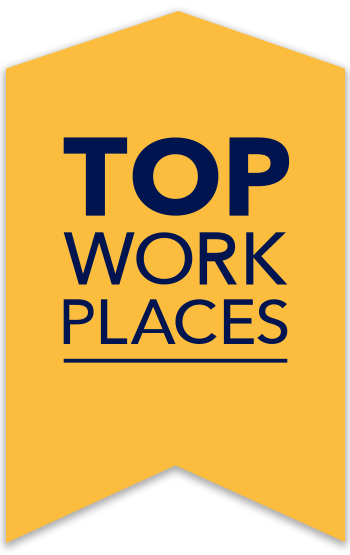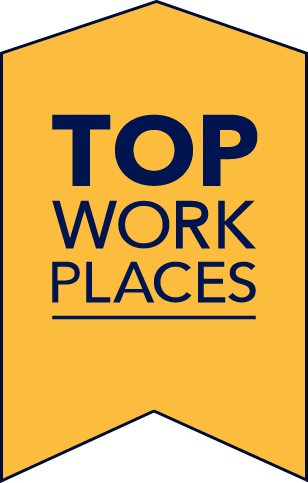Ensuring your employees are connected and engaged is impactful for your business. But employee engagement isn’t just about office perks and bonuses. It’s about leaning into what matters most to your employees, so they want to stay, refer others to your organization, and give their best every day. When you improve employee engagement, you also:
- improve employee morale
- improve employee productivity and performance
- improve employee recruitment
- improve employee retention
- increase innovation and creativity
Here, we’ll discuss employee engagement, offer helpful strategies, and share examples from award-winning Top Workplaces.
What is employee engagement?
There are tons of definitions and signs of employee engagement. And sometimes, the terms employee engagement and job satisfaction are used interchangeably. But it’s important to know that employee engagement differs from job satisfaction, which is how happy employees are in their roles.
At Top Workplaces, our definition of employee engagement is simple: Employee engagement is a positive psychological state where an employee feels an emotional commitment to the organization and its goals.
It measures how strongly employees feel connected to their work and their employer. To measure engagement, we look at three specific things:
- Loyalty: An employee’s intent to stay.
- Referral: An employee’s willingness to recommend their organization to others.
- Motivation: An employee’s drive to give their best at work.
Employees who possess all three have passion and energy — and they’re less likely to leave your organization for a different opportunity. They’re engaged and will go above and beyond for your organization.
Successful employee engagement strategies and examples
Choosing the right employee engagement strategy is essential to achieving your organization’s goals. So, let’s dive into the top employee engagement strategies and how we’ve seen them improve employee engagement with Top Workplaces winners.
1. Start with an employee engagement survey
Leaders at Top Workplaces know an effective employee engagement strategy begins with leaning into employee feedback. A confidential employee engagement survey is the best way to learn what truly matters to your people, from alignment to connection to employee relationships with their manager and performance effectiveness. It’s how you’ll know where your culture excels, where it can improve, and how it stands against the competition.
2. Encourage transparent communication
A successful communication strategy helps to ensure employees are connected and engaged. Top-down, one-way communication may be easy. But it’s two-way, transparent communication that is key. And when the workforce is remote, it’s essential to establish guidelines for remote work. Here are three best practices used by Top Workplaces:
- Make two-way communication possible. Use your annual employee engagement survey to capture anonymous feedback and guide your decision-making. Consider shorter, more frequent pulse surveys to check in and know if messages have landed correctly.
- Encourage two-way communication in meetings. Set guidelines and encourage employees to participate, especially when they’re remote. If employees are hesitant to interact, ask them for input.
- Set aside time for casual dialogue. Leave time at the start of each meeting to check in with people. Allow them to catch up and share what’s going on.
INCOE Corporation, a family-owned, global business, experienced recent growth that threatened its communication ability. To avoid this, they initiated a multifaceted approach to ensuring two-way workplace communication, including:
- Capturing anonymous feedback via the Workplace Survey.
- An open-door policy from the top down.
- Rewards for employee suggestions.
- Anonymous call-in line.
- Free, confidential counseling services.
- Education sessions to explain benefits programs.
A year later, INCOE earned a spot on the Detroit Free Press Top Workplaces list for the first time. For Tim Chisholm, Director of Human Resources, the Top Workplaces award took a back seat to increased employee engagement:
“As employees saw us integrating their ideas, it opened it up for even more employees to come forward and share their thoughts. People have many ideas. You’ve just got to stop and listen.”
3. Create a clear path for employee growth
One way to keep employees engaged is to ensure that they see a shared path forward. At Top Workplaces, this includes investing in professional development, facilitating mentorships, and promoting from within. It’s also key to improving the hiring process.
Employees value companies that are invested in their personal development, and — not surprisingly — employees are likelier to stick around when they believe the company wants to invest in them rather than hire new talent with the necessary skills. According to LinkedIn, 94 percent of employees report they would “stay at a company longer if it invested in their career.”
Professional development is an emphasis at Tutton Insurance, a multi-year winner Top Workplaces winner. Tutton’s Executive Vice President and Controller, Katy Portfolio commented:
“Not all companies like ours will encourage or pay for an industry designation. Our president feels like the best strategy for us to differentiate ourselves from others in the industry is to be more knowledgeable. He will pay for the education. He’ll pay for the designation. So, when we show up with the designation behind our name, it gives credence to us being a little better than our competitors.”
Skill development improves employee performance, so it’s essential to make employees aware of internal growth opportunities. It shows your investment in the team and helps promote internal recruitment and retention by providing employees with concrete examples of how they can progress their careers at the organization. And when employees see a path for growth, the company gains employee retention benefits.
4. Trust your employees and give them autonomy
Trust goes both ways. When employees and employers trust each other, it encourages employee engagement. Clayton at Arista Home Care Solutions, a Top Workplaces organization, says:
“We work hard to earn the trust of our employees. We care about their trust because we know it will lead to how successfully they care for our patients.”
5. Compensate and recognize employees for their work
Top Workplaces don’t distinguish themselves with more significant benefits or higher pay. Yet, in an increasingly transparent and competitive labor market, it’s essential to structure your compensation structure to attract and retain employees.
When employees perform above and beyond their expected role, show them how their work is valued and benefits the organization. Whether through bonuses or non-financial incentives like public shout-outs or an extra PTO day, appreciating your employees’ hard work ensures they stay engaged.
Leaders at Fellowship Community, a multi-year Top Workplaces winner, know their culture of employee appreciation is at the heart of satisfaction for both residents and employees. Chief operating officer Donna Conley remarked:
“We’re proactive about coming up with things to let employees know they are appreciated.”
Related: Workplace Appreciation
6. Consider your office layout
Office layout creates a positive work environment and enhances employee engagement. Consider natural lighting, ergonomic furniture, and flexible workspaces to create a comfortable and productive workspace.
Employees are more likely to feel valued, motivated, and invested in their work by providing an engaging and supportive physical environment, leading to higher job satisfaction, productivity, and retention rates.
American Integrity Insurance built a Top Workplaces culture with an innovative approach to recruiting, “extraordinary experiences,” and a focus on gratitude. According to Michael Goodman, human resources director:
“It seems counterintuitive to think of a modern workplace as a place of tranquility, but that is exactly our approach. We want to make these eight hours precious, valuable, even joyful.”
7. Encourage PTO and employee offsites
Creating a culture that embraces a healthy work/life balance ensures employees can live the lives they want while remaining fresh, engaged, and productive at work. Promoting workplace flexibility (especially in a remote environment) helps people manage their time according to what works best.
Ensuring you have established guidelines and protocols helps mitigate any risk of allowing employees to set their schedules. You’ll find that they can take breaks, recharge, and return to work focused.
Another way to ensure your employees achieve work/life balance is to allow them to disconnect from day-to-day work tasks with activities such as company retreats or volunteer opportunities. Make sure to choose an activity that aligns with your company values.
For President Marty Kaufman, president of Accent Computer Solutions Inc., encouraging work-life balance is a priority:
“My catchphrase is: We don’t want to torture our employees or customers. But seriously, if you’re working your employees too hard and not delivering exceptional services to the client, both are unhappy.”
Another way to embrace work-life balance is to encourage employees to use their PTO. Ensuring employees can focus on their work while in-office but have room to travel, pursue their passions, or recharge is critical.
8. Prioritize diversity, equity, and inclusion
Before we discuss the role of diversity, equity, and inclusion (DE&I), let’s clarify the definition of each term within the workplace:
- Diversity is the collective composition of teams and organizations.
- Equity refers to proportional representation and acknowledges the different needs of employees.
- Inclusion relates to value and presenting an equal opportunity to participate and contribute.
DE&I plays a vital role in employee engagement as well as business success. When employees believe there is a lack of diversity and inclusion within your culture, it hits hard on employee engagement — and according to one study, this is especially true for millennials.
Eighty-three percent are actively engaged when they believe their organization fosters an inclusive culture, compared to only 60 percent of millennials who are actively engaged when their organization does not foster an inclusive culture. As you craft your employee engagement strategies, include and prioritize your DE&I efforts.
Related: How to Promote Diversity, Equity, and Inclusion in the Workplace
9. Keep remote employees engaged
In today’s world, remote employee engagement is critical for ensuring all employees feel connected to their organization and motivated to perform at their best. Foster remote employee engagement by providing opportunities for virtual collaboration, recognizing and rewarding remote employees’ contributions, and implementing regular communication channels.
By prioritizing remote employee engagement, organizations can maintain a strong company culture, retain top talent, and drive business success.
10. Hold managers and employees accountable
If managers and other leaders are not leading by example, holding them accountable is essential. The only way that employees will feel motivated to improve their engagement is if they see a role model gaining benefits and enjoying the process.
It’s crucial to hold every employee, manager, and leader accountable. Otherwise, a handful of individuals could get burnt out from being responsible for everyone else’s engagement. It’s helpful to start holding managers accountable first. Then, you can focus on the lower-level employees.
11. Build a people-first culture focused on employee well-being
Successful organizations know the importance of building a people-first culture, focusing on employee well-being, and implementing strategies to prevent workplace burnout. Well-being has a significant impact on employee engagement and performance. Ensuring your people are happy and healthy encourages higher productivity and satisfaction for the individual and the company. Bob Grennes, Commissioner at the Indiana Department of Revenue, knows the importance of building a people-first culture:
“In the end, it’s all about our people. Organizations are nothing more than a collection of people who bring their passions, skills, and diverse backgrounds to their mission. That’s what makes the magic.”
12. Stay true to your company’s core values and mission
Sustainable success comes from both engaged employees and strong core values. When a company intentionally promotes its core values, mission, and vision, it attracts employees with shared values. Strong values motivate and satisfy employees and managers, improving engagement, brand reputation, and internal company culture.
Samantha Green at TEAM Schostak understands how strong values impact company culture:
“Culture at TEAM Schostak is huge. Our culture is driven by a roadmap that includes our vision, our mission, and our core values. It’s all centered on our people. That’s always been the driving force of who we are and where we want to go.”
13. Become an Employee Engagement Specialist
Becoming an Employee Engagement Specialist gives you a solid foundation for positively impacting your organization’s engagement. With this certification, you can:
- Demonstrate your knowledge of employee engagement.
- Boost your professional reputation with a certification from a trusted source.
- Advance your career as an employee engagement specialist.
- Join a network of like-minded professionals committed to building engaged workplaces.
- Access exclusive resources that help reinforce and apply the learning.
Top Workplaces offers the Employee Engagement Essentials, a self-paced, six-module online learning course. Get the details here.
Tips for developing your employee engagement strategy
- Ask questions
- Be transparent and realistic
- Be flexible
- Communicate clearly
- Focus on people first
- Record the data
Employee engagement roles: who should be involved
The right employee engagement strategy is a catalyst for performance — and the bottom line. It requires alignment and buy-in throughout the organization, from managers and human resources to senior leaders, the C-suite, and even the IT team.
Managers are mission-critical for the day-to-day understanding of progress through employee engagement strategies. Communication is one of the essential qualities of a good manager. They are responsible for communicating company priorities and helping the team see how they can positively impact. Managers are also responsible for sharing with senior leaders areas of opportunity where the team can contribute.
- HR needs to help secure buy-in and communicate opportunities for growth and transparency into organizational changes.
- Senior leaders and the C-suite bring a strategic vision to the table. They need to understand the importance of an engagement initiative, how it can strengthen the organization, and how it impacts buy-in.
- IT is critical to ensuring effective and efficient communication lines and ensuring the team has proper access to the technology they need to communicate.
These aren’t the only team members who should be involved in developing a robust employee engagement strategy. Tap into employee leaders to gain feedback and ensure they help gain buy-in from the team. If employees are resistant, you will fight an uphill battle that will impact your initiative’s success.
Measure and iterate on your employee engagement strategy
Once you have created and launched the employee engagement strategies you wish to use, capture feedback on what’s working — and what’s not. Measuring and iterating on your employee engagement strategy is critical to long-term success. Here are two suggestions:
- Regular 1:1s between managers and employees create two-way communication and dialogue.
- Annual employee engagement surveys capture candid, anonymous feedback at the strategic level. The results also provide a dataset measured against benchmarks across the organization.
- Short, targeted custom pulse surveys make checking in and tracking the progress of your employee engagement strategies quick and easy.
Improve engagement in your organization
Start building your employee engagement strategy today. Top Workplaces is the employer recognition program based on employee feedback captured by a research-backed employee engagement survey. To participate, begin by nominating your organization here.

 Stand out with an award-winning
Stand out with an award-winning